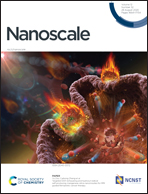Role of carrier-transfer in the optical nonlinearity of graphene/Bi2Te3 heterojunctions†
Abstract
Two-dimensional (2D) topological insulators (TIs) have attracted a lot of attention owing to their striking optical nonlinearity. However, the ultra-low saturable intensity (SI) of TIs resulting from the bulk conduction band limits their applications, such as in mode-locking solid-state lasers. In this work, through fabricating a graphene/Bi2Te3 heterojunction which combines monolayer graphene and a Bi2Te3 nanoplate, the optical nonlinearities are analyzed. Moreover, the thickness-dependent characteristics are also investigated by varying the thickness of the Bi2Te3 when synthesizing the heterojunctions. Furthermore, with the aid of the estimated junction electron escape time, a model of the photo-excited carrier-transfer mechanism is proposed and used to describe the phenomena of depression of ultra-low saturable absorption (SA) from the Bi2Te3 bulk band. The increased modulation depth of the graphene/Bi2Te3 heterojunction can accordingly be realized in more detail. In addition, a Q-switched solid-state laser operating at 1064 nm with heterojunction saturable absorbers is built up and characterized for validating the proposed model. The laser performance with varied Bi2Te3 thickness, such as pulse duration and repetition rate, agrees quite well with our proposed model. Our work demonstrates the functionality of optical nonlinear engineering by tuning the thickness of the graphene/Bi2Te3 heterojunction and demonstrates its potential for applications.



 Please wait while we load your content...
Please wait while we load your content...